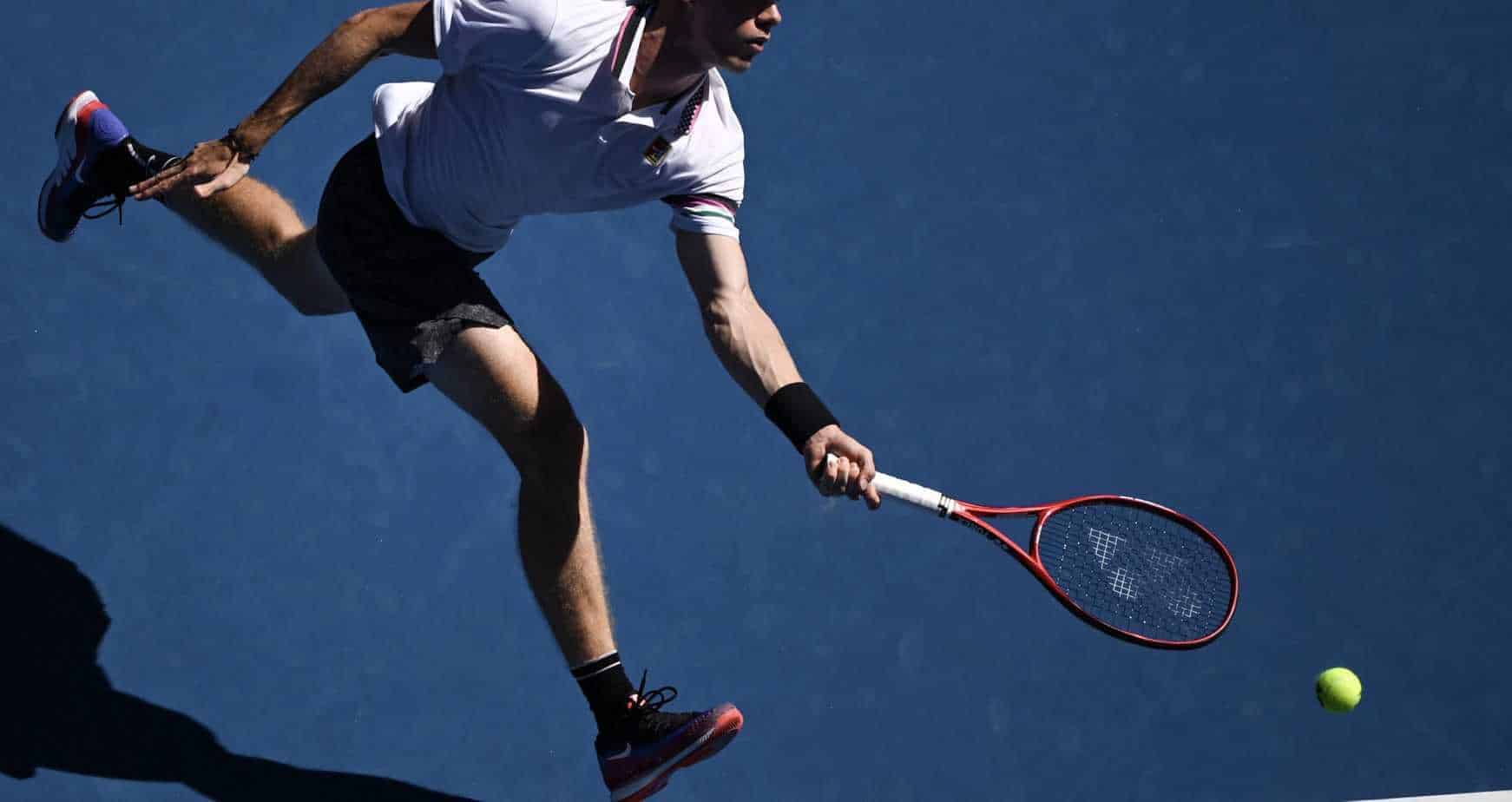When choosing the equipment to use, it is important to be well informed about what you’re looking at in order to know what will work best for you. Whether it’s strings, rackets, shoes, grips, or even clothing, everyone has different preferences.
With so many different brands and types of strings on the market, it can be difficult to decide what is best for you. With our experience playing and testing gear over the years, we are here to provide our insight so that you can make a good choice to help your game.
The types of string that you will want to consider are Polyester, natural gut, synthetic gut, multifilament, and hybrid. These types of string will all contribute to different factors in the way the string plays. The main factors that you will want to consider are power, spin, comfort, control, touch, string movement, playability duration, and durability. Based on your gamestyle, injury proneness, and budget, these things will help you to find a string that brings you success on the court.
There are clearly a lot of things to consider when selecting a string. Keep reading below for more of an explanation of the different types of strings, details of what each factor means, professional recommendations, and more.
If you see a string you’d like to check out for yourself along the way, click any picture to be sent to our friends at Tennis Warehouse. There you will be able to select from a wide range of options.
What are the different types of tennis strings?
As we touched on above, the types of strings on the market are polyester, natural gut, synthetic gut, multifilament, and hybrid. Below is an overview of each of these types of string, and what you can expect out of each of them in general.
Polyester:
This type of string is made of polyester. Many of the strings on the market are considered “poly” strings, but have a slightly differing composition. Many will be called “co-polyester monofilament” or something like that. Don’t let it confuse you, this is just a more specific detailing of what the poly string is composed of.
Polyester strings are most well known for their durability over time, and ease in generating power and spin. Polyester strings will generally be less comfortable on joints over time, so this should be kept in mind if a player has chronic pain in their shoulder, elbow, or wrist.
Natural Gut:
Natural gut string is actually made of… drumroll please… cow intestine. The material used is found at the outermost layer of the cow intestine called the serosa. The food industry provides this material to string makers, as this part of the cow is not consumed.
As far as the string itself, tennis players love it. While natural gut is far more expensive than the other types of string, the comfort and control that it provides is unmatched. Because it is so expensive, most players that use it pair it with another string so that they only use half a set per racket. Natural gut string is also low rated in durability, so the pairing of another string gives it a bit more life in the racket before it breaks.
The general consensus among most high level players is that if they can afford to use it, they will. However, this string is so expensive that even string companies have a hard time affording to give it to sponsored players for free. If it is in the budget, it is definitely worth a shot!
Synthetic Gut:
As it is obvious by the name, synthetic gut is not made from cow intestines. This string was produced to mimic the feel and comfort of natural gut, but at a more affordable price. This is a great option for players looking for more feel, touch, and control in their game at about a quarter of the price of natural gut. This string is great when paired with another type of string such as a polyester because their qualities balance each other out nicely.
Multifilament:
This type of string is made by twisting different types of strings together to, in theory, create a combination of all of them. These strings are known to have a solid, all-around feel that produces a combination of spin, power, control, and durability. Of all of the types of string, multifilaments best combine playability and durability, making it the best option for your average tennis player.
Hybrid:
We touched on this a bit above, but a hybrid is when 2 strings are combined separately in the string bed of one racket. It is most common to mix polyesters with natural gut, synthetic gut, or multifilament strings to combine the characteristics of each. For example, Roger Federer uses natural gut in the main strings, and a polyester in the cross strings.
Because this is such a common thing to do, string companies such as Wilson sell “sets” of string in pairs that compliment each other well. This makes it convenient for consumers to find exactly what they are looking for.
String Factors Explained
Now that you better understand the types of string out there, you can better assess what you should be looking for. We mentioned that the main factors to consider in strings are power, spin, comfort, control, touch, string movement, playability duration, and durability. Because you now know which types of strings will warrant these characteristics, here is an in depth look at what the characteristics mean.
Power:
This is simply how “big” your ball comes off the strings with little effort. Power is the amount of pop are you getting, mostly on serves and groundstrokes.
Spin:
This rating tells you how much spin a string provides. The shape of a string often has the biggest effect on this rating, and we explain this further later in the article.
Comfort:
This characteristic reflects how the string makes your body feel, especially over longer periods of time. Natural gut, for example, will be much more comfortable than polyester.
Control:
This will indicate how easily it is to control the ball when contact is made. Elements such as power and spin do affect this rating, so this number shouldn’t come as a surprise when you see it compared to the other string ratings.
Touch:
This rating is most applicable to volleys, drop shots, and slices. This rating is often similar to the rating of control from string to string.
String Movement:
This rating is based on how much the strings move while hitting. Some strings move quite a bit during play and require adjustments after each point, while other stay secure. This is more of an issue of preference, but it affects how often the strings break and how quickly they lose tension.
Playability Duration:
This rating will tell you how long the string will perform well. As strings are used, they lose their freshness at different rates. Strings with a low playability duration will end up with a “mushy” feeling over time, and will require restringing before they break. This rating is different from durability for that reason.
Durability:
This is based on how long the strings last before they break. This is different from “playability duration” because this rating is solely based on how long the string takes to break, not how the string feels right before it does.
What strings do pros use?
If it works for them, it should work for you too. Right? Well, not always. While it is fun to use the same gear as the pros, make sure you test it out for yourself too.
Just like your preferences will be different than your peers’, the pros have different preferences from each other as well. Professional players are picky about what they use and most of them don’t tinker with gear often, as they have generally found success by using the same equipment for years.
Polyester strings are most popular among professional players ranked inside the top 500. This is because most players inside of this ranking get their string for free from sponsors, and the sponsors are willing to give polyester string for free. This also has to do with the fact that most professional players are young and healthy, so they are able to handle the fact that it isn’t so soft on the arm.
Many of the top 100 pros use a hybrid setup of polyester and natural gut. This is because it is widely known to be the best feeling combination of string. However, this setup is not for everyone. That is why players such as Federer use a hybrid combo, and Nadal uses a full polyester string. Every player has different preferences, and it is important for the player to use what is best for them.
Below are a few of the strings that are endorsed by top professional players.
Roger Federer
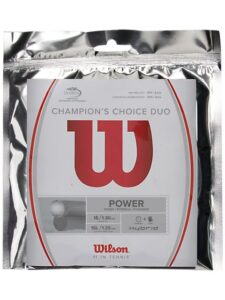
Rafael Nadal

Andy Murray
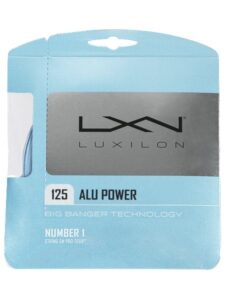
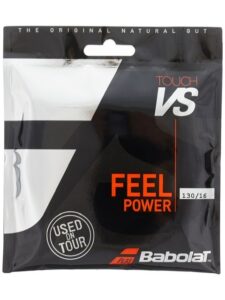
Dominic Thiem

Stan Wawrinka

Nick Kyrgios
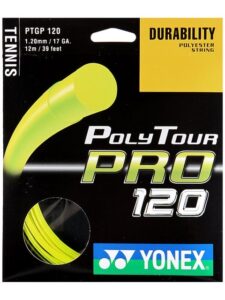
What tension should you use?
Again, this comes down to preference. If you are unsure, you should start by knowing how different tensions will effect your game.
Most rackets are strung between 45 lbs and 60 lbs. The looser you string your rackets (less pounds) the more power you will gain. The tighter you string (more pounds) the more control you will gain. Looser tensions are also easier on joints, so that is something to consider.
The type of string you choose to use will also be a factor in what you tension you decide to string your racket at. Polyesters should be strung looser, as a polyester string that is too tight can cause pain. Because polyester strings generate more spin, you won’t have a problem controlling the looser tension. As a general rule, synthetic and natural gut strings should be strung at least 2-5 lbs tighter than your polyester string. Most microfilaments should be strung with tension somewhere in between that of polyester and gut.
Your string tension should also be determined by the racket that you are using. On Tennis Warehouse, each racket has a recommended tension guide. We highly recommend checking that out if you are unsure what tension is best for the racket you use.
If you are completely unfamiliar with string tension, start with a tension around 52 lbs and work up or down from there. Remember that the longer you play with a racket, the looser the strings will get.
Tennis String Gauge Meaning
The gauge of a string is the thickness. For example, Babolat’s RPM Blast is sold in 17g and a 16g. It’s the same exact string by it‘s property, but the 17 gauge will produce more power. Because it is thinner, it will break much quicker.
From my experience, thinner strings are much more comfortable and have a higher playability rating. However, it can be annoying and expensive to break strings frequently. Because synthetic and natural gut breaks faster, you should be looking for a lower gauge (thicker) in those types of string.
There are a couple of different numbers that relate to thickness: gauge and MM. They refer to the same thing, string thickness. MM refers to the diameter of the string. For some odd reason, manufacturers have slightly varying numbers when it comes to this. Here’s a quick table showing what each number means so you don’t get confused:

Tennis String Shapes
As string technology has advanced, manufacturers have found that different string shapes provide different shot feedback. This is most common in polyester strings.
The shape of a string is mostly determined by the strings edges. The idea is that the more edges (and therefore corners) a string has, the more it will grab onto the ball, producing spin. Most strings will specify a string’s shape on it‘s packaging or online.
Tennis Strings Recommendations
Alright, now that you better understand what strings you should be looking for, here are a few of our favorites. We’ve given a few from each of our favorite brands. We recommend deciding on a type of string before you decide on a brand.
Solinco
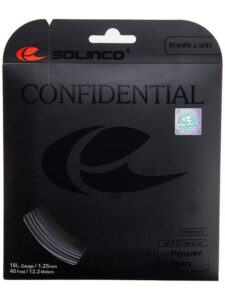
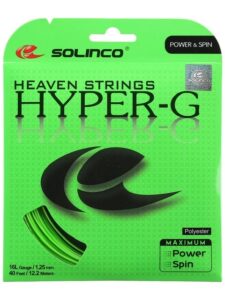
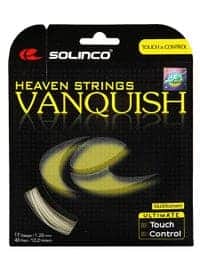
Diadem

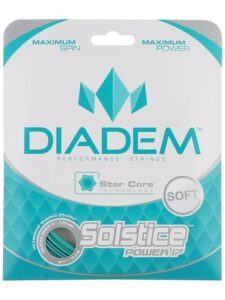

Wilson

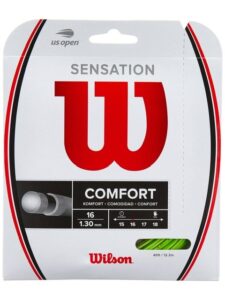
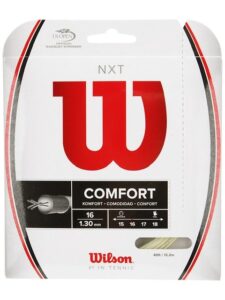
Head

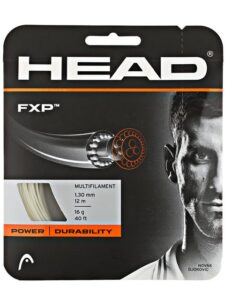

Babolat



Best Tennis Strings for Beginners
When beginners ask me what types of strings I recommend that they use, I like to point them in the direction of multifilaments and synthetic guts. Here is why…
Beginner players are not experienced enough to be able to really tell a difference between a really expensive string (natural gut) and a cheap multifilament. But price aside, I think that it is important for players to begin with a string that will be easy on their arm. Beginners are not used to the impact of the ball on the strings, and soft strings will prevent injury.
Additionally, beginners usually do not break strings frequently at all, so durability is a nonissue. Here are a few strings we highly recommend for players just beginning their tennis journey:



Final Thoughts
After reading this article, you will probably know more than you thought you ever would about tennis strings. Now you can be better informed before you choose a string. We recommend that when switching strings, you buy a couple of different sets. They are reasonably priced and it won’t be the end of the world if you don’t like one. It is better to experiment with a couple of types of strings before you make your choice, so that you can be confident going forward.
Did you find this article helpful? Anything we missed? Either way, let us know in the comments below, or reach out to us on our instagram at @MyTennisHQ.

